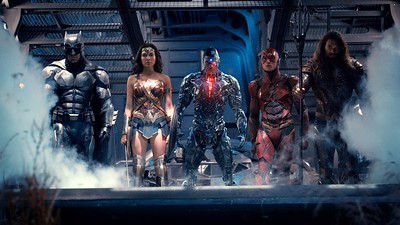“Zack Snyder’s Justice League” reveals a shifted faith towards past projects

The Justice League assembling
I have not yet seen the theatrical cut of “Justice League,” released in 2017. I’ve been a DC Comics fan for a while now; I think I first flipped through “The Dark Knight Returns” before attending kindergarten. Not that I knew what I was reading, only that Batman was in it, and that he was fighting Superman. I certainly could not recognize the subversive nature of “The Dark Knight Returns” as a child, or see why the two superheroes were fighting, and never got around to revisiting the comic until I found it within Hege Library’s collection, just around the time “Justice League” opened in theaters.
“Justice League” contains the follow-up story to 2016’s “Batman v. Superman: Dawn of Justice,” which adapts in part the caped fella’s fight from “The Dark Knight Returns.” Critical and audience responses to “Batman v. Superman” were dismal.
A friend of mine who’d gone to theaters for his viewing cautioned me not to do the same, saying, “I wonder if destroying art is not always a bad thing to do.”
Warned by my friend and the world at large, I skipped “Batman v. Superman,” and did the same with “Justice League”. I’m not much of a fan of Zack Snyder to begin with; his visual style is overwhelming with color saturation, and he seems to focus on a machismo of sorts that implies that his protagonists’ lives are more valuable than all other characters. The reviews for “Justice League” weren’t that great, anyway. I heard it called “a very long trailer for another, yet unmade, film.”
That’s not enough to convince me to drop money/time on a theater experience for it. Or a streaming experience, for that matter.
Snyder’s involvement in adapting DC stories is in theory a good idea. His proclivity towards dourness fits in with the dark themes of “The Dark Knight Returns” graphic novel. This should have made it easier for him to turn the graphic novel into “Batman v. Superman,” but I guess all directors have their weaker features.
After “Batman v. Superman” tanked, Warner Bros. Pictures got cold feet on the DC Comics-based adaptations Snyder had planned for them, and wanted Snyder’s vision to be more similar to that of Marvel’s action comedies. Then, Snyder had to leave filmmaking altogether after the suicide of his daughter. Warner Bros. pulled in “The Avengers” director Joss Whedon to finish up “Justice League,” released the film to theaters and lost a bunch of money on it when the initial targeted fan base was not impressed by trailers featuring the mish-mash of Snyder’s serious visuals and Whedon’s humor, the latter of which came across as lame.
Snyder loyalists believed that studio meddling and personal tragedy kept the “Justice League” film from reaching its full potential under their favorite director’s guiding hand. In the years since the theatrical premiere, these fans petitioned for an imagined “Snyder Cut” of the film to be released, based on the assumption that Snyder had completed a full Justice League film before getting kicked off the project. Snyder had not, but his loud and consistent fans got Warner Bros.’ attention. The studio hired Snyder once again, and on March 18, “Zack Snyder’s Justice League” was released on HBOmax for the willing subscriber. It cost $70 million to make, extended the theatrical runtime from two hours long to four hours long and, according to the small group of socially distanced gentlemen I watched the film with, includes “improvements all around.” A church friend offered his account for a group viewing.
And yeah, I had a fun time watching it. Not as much fun as I have had with any given Marvel film, no. I can’t tell what has been added to from the theatrical cut for the four-hour long behemoth that Snyder’s cut is. But I enjoyed it. The fight scenes have that kinetic energy that keeps one from knowing just what will happen next to the bodies in play, even if most viewers will accurately guess how the fights end.
I wanted the titular “Justice League” to win on the grounds of seeing their characters’ desire to save the world against slim odds, rather than wanting them to win because they are the protagonists. The core protagonists are allowed to have character when the film could have simply let them ride on the laurels of how we understand them to be in the cultural zeitgeist alone. Zack Snyder, it is clear, cares for these characters.
I don’t think I will watch it again, not like I do with better films of a comparable runtime, such as “Titanic,” “The Lord of the Rings: Return of the King” and “Gone With the Wind”. It is not really a “good” film, either; if it were going for a Guilford letter grade, I’d give it a “C” for passing, but only just.
Given that the Snyder cinematic vision for DC Comics’ properties has more or less been thrown away by Warner Bros., the follow-up films and sequels teased by Snyder’s cut are no more than prompts for an audience to imagine what could have been; the last twenty minutes or so of the film function as a trailer to these unrealized films. The whole thing is a novelty for its production history alone. Cinephiles and devoted DC fans have something to watch in how the film engages with the intertwined legacies of DC films and cinematic history. General audiences don’t have much to watch that they can’t find elsewhere.
What interests me most about “Zack Snyder’s Justice League” is less so the film itself and more so the audience’s hunger for an alternate version of an officially released film. Snyder’s fans trusted his vision, grounded in Snyder’s proven ability as a talented, quality director in the past—he directed hits like 2007’s “300” and 2009’s “Watchmen,” after all. Even when “Batman v. Superman” proved a mess and the original “Justice League” did too, his fans had faith that he could make a better film than Josh Whedon/Warner Bros. did.
We consumers seem much more willing to spend time and money on different versions of a story, to explore different avenues the characters could have taken, than ever before. And if we don’t like what we see, if the product we’re presented with smells of corporate manipulation to compete against other creators (in this case Marvel), then we now know that production companies and studios are willing to finance a remake. Not just a “director’s cut” edition included in the DVD release at Walmart, or an “alternate cut” that airs on the USA TV network, types of cuts that include additional footage which had been deemed too long or too unacceptable for a theatrical release. Warner Bros.’ willingness to return to a project filmed and released more than three years ago to add new footage is something we haven’t seen before. Not to my knowledge.










